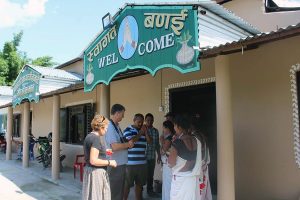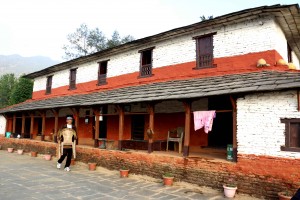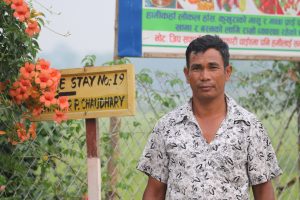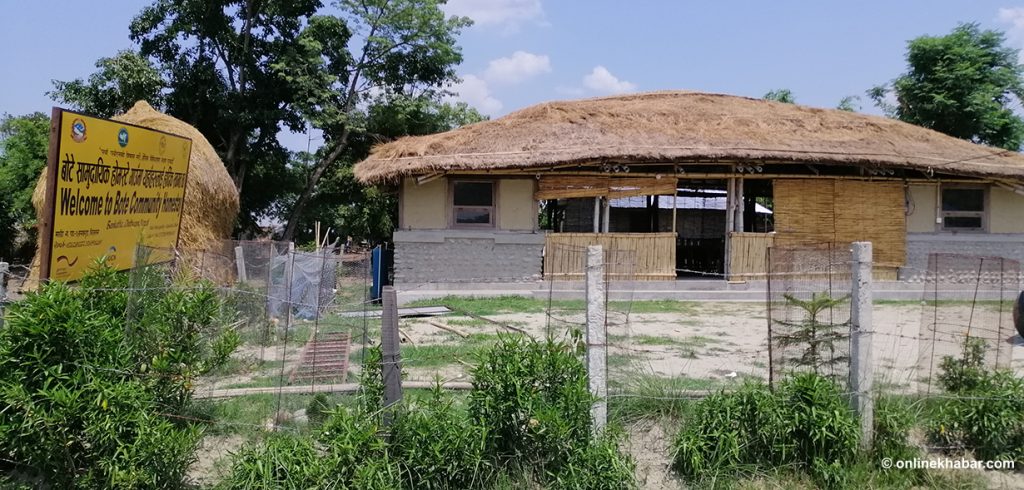
Rita Bote of Madi municipality in Chitwan is busy operating a homestay her the village these days. With the establishment of the Bote Community Homestay in the village back in 2020, the daily routine of women like Rita has undergone a remarkable transformation.
During the peak tourist season, women like her are fully occupied as they have to manage rooms, cook food and ensure the guests who come to the Bote Community Homestay are taken care of well.
“Life was very different before. Our life has completely changed thanks to Bote Community Homestay,” says Rita who says they can afford things they could only dream of.
The homestay project has been a boon to the Bote community. It has helped families send children to school and enhanced their life as many are even paying off debts through the money they make from the homestay.
Before the implementation of the homestay concept, women in this community were engaged in activities such as fishing, gathering grass and firewood from the forest, and foraging for food.
Take Phool Maya Bhote for example. At 50, she is running the homestay smoothly and is reaping the rewards as she is finally financially sustainable.
“The income generated from the homestay has made it much easier for me to send my children to school and run the household,” says Phool Maya.
Bote Community Homestay can be reached by crossing the Riu River in Madi and travelling about 1.5 kilometres west from the Seruwa gate on the main road. The homestay has been built with financial support from Madi municipality, the Panch Pandav Buffer Zone Users Group, and the Terai Arc Landscape Project (TAL).
A cosy two-room homestay has been constructed for around Rs 1 million. Currently, the Bote Community Homestay project comprises 12 homestays, providing accommodation for a total of 60 people.
The locals at the Bote Community Homestay extend a warm welcome to tourists, embracing their cultural traditions. Following the Bote community’s practice of Binti Bati, which involves showing respect to older dignitaries and guests, the hosts’ place tika (a vermillion mark) on the foreheads of the guests and offer them flowers. Subsequently, the guests are guided to a community building constructed using bamboo.
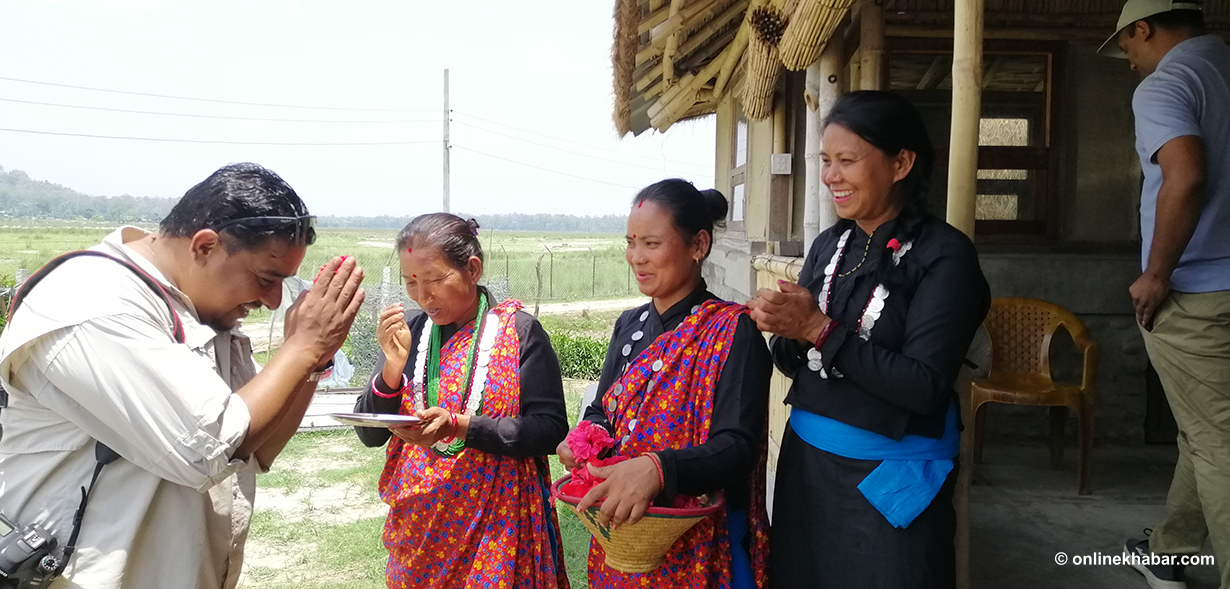
As the Bote community sustains their livelihood through fishing, they welcome guests by offering fish chokha (pickle) and chhyang (local alcoholic beverage). The cost for a one-night stay at a homestay is Rs 600, with an additional Rs 300 for food, which includes meat dishes. This is worth it as guests are treated to an array of culinary delights, including various duck items and local ethnic dishes such as pickled fish, ghongi (snail), and bamboo shoot chokha.
Following the delightful culinary experience, the guests are treated to captivating cultural programs that showcase the rich traditions of the Bote community. These programs at Bote Community Homestay feature enchanting local dances and melodious songs, providing a glimpse into their vibrant and traditional culture.
A specialised team of around 20 individuals has been assembled to entertain the guests with captivating cultural performances. To witness these cultural programs, a group is required to pay a fee of Rs 3,000. Jag Narayan Bote, the treasurer of Bote Community Homestay, highlights the significance of these activities in safeguarding the endangered Bote culture in the area.
The homestays provide an opportunity for guests to embark on tours to nearby attractions. These include visits to the Gorakhnath Temple, which is just 500 meters away from the homestay, the Panch Pandav Temple located 1 kilometer away, the Ashta Shiva Linga at a distance of 1.5 kilometers and the Parashuram Kund, which is 4 kilometers away.
The operation of the homestays has sparked a commercialisation trend among the locals, who have ventured into chicken, duck, goat, and fish farming, in addition to vegetable cultivation.
To facilitate financial support for these ventures, village groups have been formed to collect funds, and loans are provided at a six per cent interest rate to aspiring entrepreneurs.
“This initiative has proven beneficial in avoiding the pitfalls of microfinance”, says Prem Paudel programme coordinator of Bote Community Homestay.
According to Narayan Sapkota, the president of the Panch Pandav User Group, while the Bote caste has previously been involved in running homestays alongside other castes, this particular homestay is the first one exclusively operated by the Bote community.
Sapkota, serving as both the president of the Panch Pandav Buffer Zone Users Group and the president of the group itself, highlights that the homestay has received support from the group in the form of furniture, home decor items and water tank stands.
Paudel mentioned that the Terai Arc Landscape Project (TAL) has extended financial support to each homestay, providing assistance of Rs 25,000 to facilitate their operational activities.
“TAL has played a crucial role in forming groups, organizing homestay training programs, and supporting income generation initiatives for the local community. Their assistance has been instrumental in empowering the locals to establish and operate successful homestays, contributing to sustainable economic growth in the region,” says Paudel.
Over that last two year, Bote Community Homestay has successfully hosted more than 5,000 tourists, comprising both local and foreigners. These individuals have chosen the homestay as their preferred destination to partake in the genuine warmth of the community’s hospitality and engage in an immersive experience of the local culture. With its rising popularity, the homestay has emerged as a sought-after choice for travelers seeking an authentic and enriching sojourn in the region.
“Each homestay made over Rs 500,000 in the past two years,” says Jag Narayan, the homestay’s treasurer.
Reduced dependence on forests

The Bote community, residing in close proximity to Chitwan National Park, has been facing issues with wildlife. The settlement frequently experiences crop damage and destruction caused by wild animals.
Tragically, incidents have occurred where these animals have harmed individuals and even claimed lives, leading to a surge in conflicts between humans and wildlife. The escalating encounters underscore the challenges faced by the community in coexisting with the natural habitat of the park.
According to Sapkota, the introduction of the homestay concept was aimed at mitigating the growing human-wildlife conflict. By providing alternative economic opportunities and promoting tourism, the homestay initiative seeks to reduce the pressure on the surrounding natural habitat and minimize the frequency of conflicts between the local community and wildlife as people do not enter the forest as much.
“We have been successful to an extent. The homestay has also helped in the preservation and revival of the lost culture of the Bote community,” says Sapkota.
The operation of the homestay has not only brought economic benefits but has also contributed to the development of leadership skills and capacities among local women.
Sapkota highlights the transformative impact, noting that previously, the women would shy away and hide when encountering new individuals in the village. However, with their involvement in the homestay activities, they have gained confidence and now actively engage in conversations and extend warm welcomes to guests, showcasing their enhanced communication and hospitality skills.
The women here are now involved in forest and wildlife conservation campaigns too. A few years ago, Rita’s father-in-law Shukra Bahadur Bote was attacked by a rhinoceros and got seriously injured. A large amount of money was also spent on his treatment.
But Rita has no grudge towards wild animals including rhinoceros. She has started the rhino conservation campaign herself.
“There is hardly a house in this area that has not been victimised by wild animals, but they have helped in conservation,” says Prakash Dhungana, chairperson of the Buffer Zone Management Committee, “After reducing the dependence on the forest, conflicts have also decreased.”
This story was translated from the original Nepali version and edited for clarity and length.






